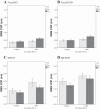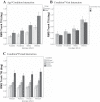The effect of age on postural and cognitive task performance while using vibrotactile feedback
- PMID: 25589585
- PMCID: PMC4416543
- DOI: 10.1152/jn.00083.2014
The effect of age on postural and cognitive task performance while using vibrotactile feedback
Abstract
Vibrotactile feedback (VTF) has been shown to improve balance performance in healthy people and people with vestibular disorders in a single-task experimental condition. It is unclear how age-related changes in balance affect the ability to use VTF and if there are different attentional requirements for old and young adults when using VTF. Twenty younger and 20 older subjects participated in this two-visit study to examine the effect of age, VTF, sensory condition, cognitive task, duration of time, and visit on postural and cognitive performance. Postural performance outcome measures included root mean square of center of pressure (COP) and trunk tilt, and cognitive performance was assessed using the reaction time (RT) from an auditory choice RT task. The results showed that compared with younger adults, older adults had an increase in COP in fixed platform conditions when using VTF, although they were able to reduce COP during sway-referenced platform conditions. Older adults also did not benefit fully from using VTF in their first session. The RTs for the secondary cognitive tasks increased significantly while using the VTF in both younger and older adults. Older adults had a larger increase compared with younger adults, suggesting that greater attentional demands were required in older adults when using VTF information. Future training protocols for VTF should take into consideration the effect of aging.
Keywords: aging; balance; dual task; postural sway; reaction time; sensory substitution; vibrotactile feedback.
Copyright © 2015 the American Physiological Society.
Figures





Similar articles
-
The Use of Vibrotactile Feedback During Dual-Task Standing Balance Conditions in People With Unilateral Vestibular Hypofunction.Otol Neurotol. 2018 Jun;39(5):e349-e356. doi: 10.1097/MAO.0000000000001764. Otol Neurotol. 2018. PMID: 29595580 Free PMC article. Clinical Trial.
-
Interference between postural control and spatial vs. non-spatial auditory reaction time tasks in older adults.J Vestib Res. 2015;25(2):47-55. doi: 10.3233/VES-150546. J Vestib Res. 2015. PMID: 26410669
-
Effects of aging and tactile stochastic resonance on postural performance and postural control in a sensory conflict task.Somatosens Mot Res. 2015;32(2):128-35. doi: 10.3109/08990220.2015.1004045. Epub 2015 Apr 17. Somatosens Mot Res. 2015. PMID: 25884289
-
Age-related differences in attentional cost associated with postural dual tasks: increased recruitment of generic cognitive resources in older adults.Neurosci Biobehav Rev. 2013 Sep;37(8):1824-37. doi: 10.1016/j.neubiorev.2013.07.014. Epub 2013 Aug 2. Neurosci Biobehav Rev. 2013. PMID: 23911924 Review.
-
Changes in Standing and Walking Performance Under Dual-Task Conditions Across the Lifespan.Sports Med. 2015 Dec;45(12):1739-58. doi: 10.1007/s40279-015-0369-9. Sports Med. 2015. PMID: 26253187 Free PMC article. Review.
Cited by
-
Potential Mechanisms of Sensory Augmentation Systems on Human Balance Control.Front Neurol. 2018 Nov 12;9:944. doi: 10.3389/fneur.2018.00944. eCollection 2018. Front Neurol. 2018. PMID: 30483209 Free PMC article. Review.
-
Vibrotactile display design: Quantifying the importance of age and various factors on reaction times.PLoS One. 2019 Aug 9;14(8):e0219737. doi: 10.1371/journal.pone.0219737. eCollection 2019. PLoS One. 2019. PMID: 31398207 Free PMC article.
-
Effect of Dual Tasking on Vibrotactile Feedback Guided Reaching - a Pilot Study.Haptics (2018). 2018 Jun;10893:3-14. doi: 10.1007/978-3-319-93445-7_1. Epub 2018 Jun 5. Haptics (2018). 2018. PMID: 31179445 Free PMC article.
-
Postural Control in Bilateral Vestibular Failure: Its Relation to Visual, Proprioceptive, Vestibular, and Cognitive Input.Front Neurol. 2017 Sep 1;8:444. doi: 10.3389/fneur.2017.00444. eCollection 2017. Front Neurol. 2017. PMID: 28919878 Free PMC article.
-
The Use of Vibrotactile Feedback During Dual-Task Standing Balance Conditions in People With Unilateral Vestibular Hypofunction.Otol Neurotol. 2018 Jun;39(5):e349-e356. doi: 10.1097/MAO.0000000000001764. Otol Neurotol. 2018. PMID: 29595580 Free PMC article. Clinical Trial.
References
-
- Agrawal Y, Carey JP, Della Santina CC, Schubert MC, Minor LB. Diabetes, vestibular dysfunction, and falls: analyses from the National Health and Nutrition Examination Survey. Otol Neurotol 31: 1445–1450, 2010. - PubMed
-
- Allum JH, Carpenter MG, Horslen BC, Davis JR, Honegger F, Tang KS, Kessler P. Improving impaired balance function: real-time versus carry-over effects of prosthetic feedback. Conf Proc IEEE Eng Med Biol Soc 2011: 1314–1318, 2011. - PubMed
-
- Bach-y-Rita P, Collins CC, Saunders FA, White B, Scadden L. Vision substitution by tactile image projection. Nature 221: 963–964, 1969. - PubMed
-
- Basta D, Ernst A. [Vibrotactile neurofeedback training with the Vertiguard®-RT-system. A placebo-controlled double-blinded pilot study on vestibular rehabilitation]. HNO 59: 1005–1011, 2011. - PubMed
-
- Bechly KE, Carender WJ, Myles JD, Sienko KH. Determining the preferred modality for real-time biofeedback during balance training. Gait Posture 37: 391–396, 2013. - PubMed
Publication types
MeSH terms
Grants and funding
LinkOut - more resources
Full Text Sources
Other Literature Sources
Medical

